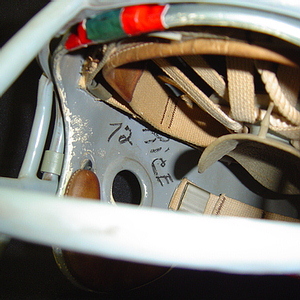

Houston Oilers
George Rice 1966-70
(Game Worn)
|
|
.jpg) |
The standard wisdom of the day in the 1950’s was that weight training of any kind would make an athlete “muscle bound” and slow moving. However in Baton Rouge, Louisiana Alvin Roy, a 1938 graduate of Istrouma High School and former aide de camp to the United States Weightlifting Team while serving in the military in Europe, believed differently. His evangelical zeal for training and continuous requests to teach this activity to the boys at his alma mater finally convinced Istrouma’s head football coach, Ellis A. “Little Fuzzy” Brown to allow the football squad to use barbells. The effect was immediate and dramatic with Istrouma Indians’ halfback Billy Cannon gaining over thirty pounds of muscle and becoming a 1955 High School All American ( see HELMET HUT http://www.helmethut.com/LSUcannon.html ). While Istrouma went on to what was an improbable and unmatched run of State Championships, winning in 1955,’56,’57, ’59,1961, and 1962, the high schools of Baton Rouge became “ground zero” for weight training for football in the United States. LSU’s National Championship team of 1958 featured an “all in-town” backfield of Cannon from Istrouma, Johnny Robinson of University High School, and Warren Rabb of Baton Rouge High School and the entire Tigers squad had already been lifting weights for two full years. Growing up in the tradition of weight training and football, George Rice sought to follow in the footsteps of his idols at Istrouma. College All Americans Cannon and Roy “Moonie” Winston had become local heroes and Rice had the talent to strive for that level of success. Located on the North side of Baton Rouge, Istrouma was traditionally a high school that educated the children of factory and mill workers, proud of its blue-collar standing, and known for physical toughness. Rice, at 6’3” and 230 pounds, was all of this and became a literal powerhouse as a two-way First Team All State tackle, leading the Indians to the 1961 State Championships.
|
|
.jpg) |
At LSU he was an immediate force and integral part of both the offense and defense, playing on the “first team,” two-way White Squad of the Tigers’ famed three-platoon team. As a senior, he had grown to 250 pounds and like a number of Istrouma stars before him that played at LSU, was named first team All American in 1965. A first-round draft choice of the Chicago Bears, Rice instead again followed in the footsteps of an Istrouma great and like Billy Cannon, signed with the Houston Oilers as their third-round pick. He was injured in the College All Star Game and not activated until mid-season of his rookie year when he began to play regularly. A starter in 1967 and ’68, he was hampered by a number of knee surgeries that followed both the 1968 and ’69 seasons and the strong, quick, and very aggressive Rice perhaps lost a step.
Many forget that the Oilers posted decent teams during Rice’s tenure, losing to Oakland in the 1967 AFL Championship Game. Rice was always a reliable and tough player and entering the 1970 camp, Wally Lemm and his staff hoped that Rice’s knee could stand up to a full season of play. When it became evident that it couldn’t, Rice opted to retire.
|
|
 |